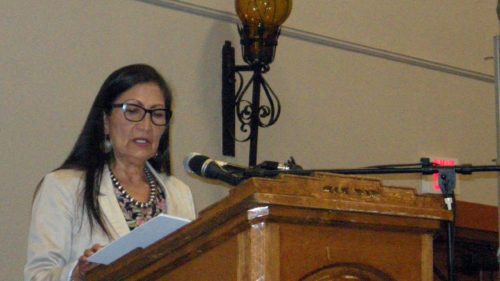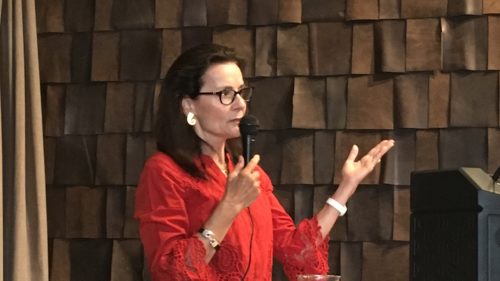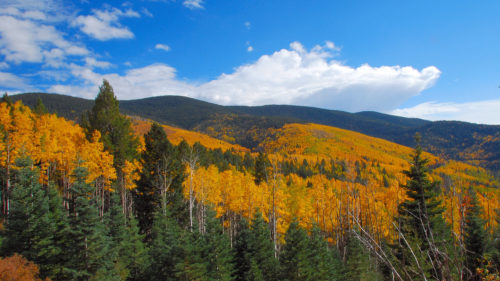The first game commission meeting of 2017 was held at Santa Fe Community College and began with a movie highlighting the accomplishments of the department of the previous year. The department was certainly busy and we commend all the great work they did for wildlife and restoration projects in 2016. We look forward to continuing to work with them in the coming year.
The commission then got down to the business of the day, first re-electing Paul Kienzle and Bill Montoya as chairman and vice chair, respectively.
After commenting on the importance of working as a team to support the commission leadership the open meetings agenda was adopted after some discussion about locations and dates. The resolution is the same as last year, but NMWF spoke in support of having a Saturday commision meeting so more members of the public may be able to attend.
Our president, John Crenshaw, got up and spoke about the importance of having Saturday meeting. Admitting that one Saturday meeting in Taos a couple years back did not have the attendance they would’ve hoped for, Crenshaw stressed that a meeting in a central location – such as Albuquerque or Santa Fe – could ensure a higher turnout. Crenshaw also noted that creating an agenda with items garnering widespread public interest – like re-opening the elk rule and tag allocation – would encourage considerable public meeting attendance.
Members of the commission seemed open to having a Saturday meeting, but picking a location and date for one was a bit of a challenge. The Albuquerque meeting in August was thrown out as a possibility, however, it would’ve interfered with the annual NMDGF outdoor expo.
Eventually, Chairman Kienzle brought up that a Saturday meeting involves staff working on a weekend. He emphasized that attendance is usually driven by agenda items, and past weekend meetings had not been successful. There was also a discussion about the additional cost of having a weekend meeting as it involves paying all staff overtime.
It was ultimately decided not to have a Saturday meeting, but we appreciate Commission Espinoza stating that the commission needs to look into ways to increase public participation.
Next up was a discussion on the progress of the Albuquerque office complex. The building is being built to LEED silver certification, and will be able to reduced or expanded as necessary in years to come.
Next up were revocations where a number of outfitters had been issued misconduct points. Kerrie Romero, executive director of the New Mexico Council of Outfitters and Guides, got up and spoke about the increase in penalties they’ve seen over the past year or two. She stressed that the outfitters just want a “black and white” list of what the department needs as some forest services require different paperwork. Chairman Kienzle responded by saying the machinery is now in place, so all the outfitters need to know what is required of them going forward.
Kienzle also brought up the idea of allowing community service in lieu of a license suspension to which Director Sandoval said it would require a rule change but that it could be looked into.
Agenda item 13 addressed the recovery plan for the white tailed ptarmigan. Presented by Stewart Liley, the department went over the range of the bird, their environmental needs, and the work the department is doing to learn more about the population numbers. A native alpine grouse-sized game bird once abundant throughout the San Juans and Sangres, the white tailed ptarmigan now only occurs in small pockets of the Sangre de Cristo Mountains. Ptarmigan stay above treeline year round, require rock fields, alpine meadows, and willows, as well as soft snow to roost during the winter. The main objective of the department is to maintain the three core populations of the species within its historical range in New Mexico. The department is doing a systematic mapping event to see where it is and where habitat could be improved, and has also taken sociological and economic considerations for the recovery plan into account. There do not seem to be any sociological or economic considerations to worry about.
Our Executive Director, Garrett Vene Klasen, gave the plan a “thumbs up” and the recovery plan was approved. NMWF would love to someday see ptarmigan restored to huntable numbers.
Stewart Liley was up again for the Agenda Item 14, about Gila monster and Gould’s turkey recovery plans. The historic and current range for the Gould’s turkey is in the bootheel and San Luis Mountains. They have a very specific range/habitat requirements and are highly dependant upon riparian areas with dependable water sources. The department knows of a “robust” population in the Peloncillo Mountains, and at last April’s count had one of the highest counts they had with about 96 birds in that area. The department is working with private landowners to get a better understanding of the amount of birds in the area. The department successfully moved 60 birds from Arizona to New Mexico and look forward to having that tool in the future.
A recovery plan for the Gila monster is also underway, who live mostly in the Chihuahuan desert scrub. Living most of their time underground, it is hard for the department to survey and get solid numbers on the Gila monster. Luckily, the commission owns some of the land with the highest concentration of distributions in the state.
The next steps for both recovery plans include: draft plan will be posted and public comments will be open for two months. Afterward, the department will need to formally adopt the plan.
Next up was an update on the Gold King Mine Spill. Eric Frey from the department gave an update on the department’s work since the spill. They have collected samples at five locations, tested over 500 fish for heavy metals, and studied macroinvertebrates. One year post spill there are relatively low levels of heavy metals at the locations – below public health risk levels.
Director Sandoval noted that the department has requested 100 percent of the money for the cleanup from the EPA but has only been reimbursed for some of it. Since the meeting, it came out that the EPA will not be paying for the Gold King Mine clean up.
Commissioner Ricklefs asked about the Cimarron river spill, where a fuel truck spilled into Cimarron Canyon. Officer Frey said about 600 gallons of diesel fuel were spilled, and the department was on site trying to contain and clean up the fuel. The department got reports of fish kills, but it seemed to be localized. An estimated 300 fish were killed and the department continues to have staff on site. Director Sandoval added that the main projects they’re working on are mostly soil and vegetation removal.
After Commission Ricklefs noted that he was there a day before and there was still an odor, Frey responded by saying the area is “pretty toxic.” A temporary closure of the area was issued and the department is working with the environmental department to collect fish to assure the public is safe before the fishing season kicks off.
NMWF is monitoring the situation and will give an update if the cleanup process becomes problematic.
Our executive director spoke again saying that the department should be proactive when it comes to spills like this. Gold King Mine spilled in the 70s and there’s nothing to indicate this won’t happen again. By amending the 1872 Mining Act and changing liability mandates, ngos, communities, and private citizens could work together to remediate legacy mines throughout the west that continue to adversely impact water quality throughout the west. “Without taking proactive steps we will see this again,” he added.
Agenda Item 18 gave an update on shooting ranges the department is working on. After one Santa Fe resident called on the commission to get Santa Fe a shooting range. Vene Klasen spoke in favor of getting a safe shooting range in Santa Fe. “I was out on La Bajada Mesa and it is wild west out there. It is dangerous and I certainly wouldn’t take my daughter out there to shoot.” Illegal shooting happens all over the state and it is very dangerous, and he encouraged the commission to make these progress as ambitious as they can be. Vene Klasen also noted that he wasn’t certain that the community of La Ciega fully supported the location of the range and this should still be publically vetted before finalizing plans to move forward with the range’s creation.
During the public comment section, Vene Klasen got up and presented our Locked Out report. Explaining that NMWF got lots of comments from our members, it’s clear this is a problem across the state. The issue is more complicated than originally thought, and the report is a preliminary draft as we continue to collect data. We will continue to build upon this report and that this issue is a bigger problem than any of us had suspected. I think we need to address it.
Chairman Kienzle stated he would put the issue on an agenda and that NMWF should continue to build out the report to make it more robust. He stressed he wants to make sure hunters are “getting what they pay for.”
Commissioner Ryan also brought up the issue of landowners being really upset about the trespassing on private property, so this is problem for private landowners and the public hunters.
We look forward to continuing to map the places where hunters have had issues accessing public lands and reporting back to the department as we go.
Finally, Vene Klasen spoke in favor of the department taking proactive steps around trapping as there is a more organized effort to ban trapping on public lands. He suggested having a mandatory online ethics course on trapping, greater setbacks and heavy fines for illegal sets so some of the issues we’ve seen can be curbed.
The next game commission meeting will be in April in Artesia.



